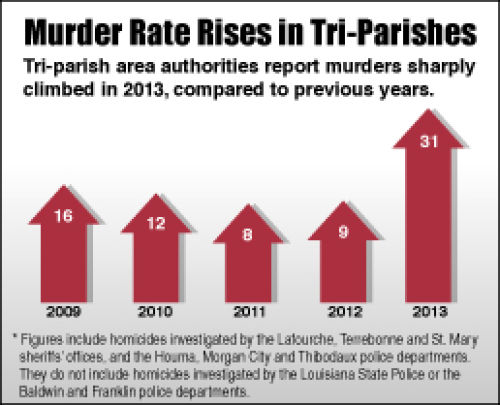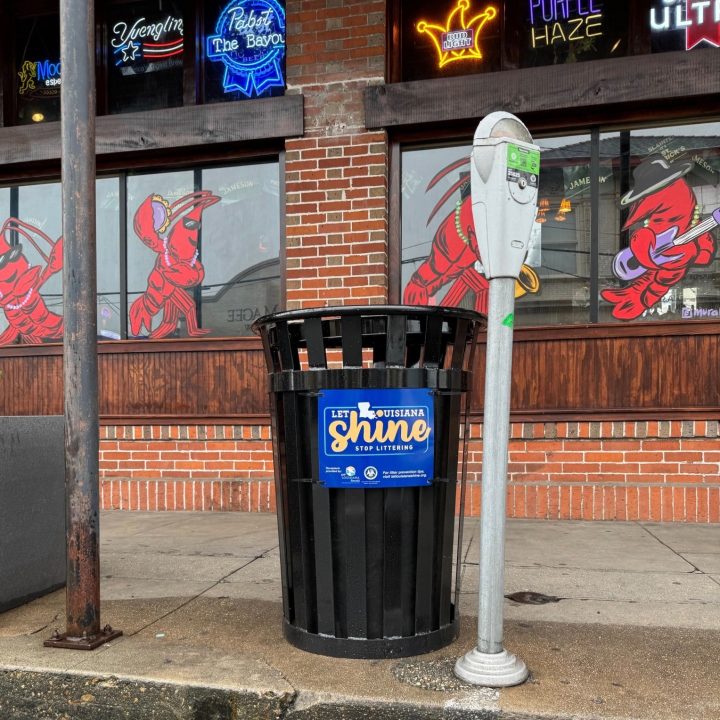
VooDoo works on barbecue, too
January 7, 2014
Carla Bernard Sapia
January 8, 2014Tri-parish detectives investigated more than three-times the amount of homicides last year than in 2012.
A rise in alleged murders was seen in all six of the area’s major law enforcement agencies – at rates that dwarf figures over the past decade – as the Tri-parish total soared from nine homicides two years ago to 31 last year, according to figures provided by the Lafourche, St. Mary and Terrebonne sheriffs’ offices and the Houma, Morgan City and Thibodaux police departments.
A year-to-year comparison shows a 244-percent increase in Tri-parish crimes; compared to an average of the previous four years, the 2013 total represents a 175-percent increase.
A prevalence of more-volatile brands of illegal narcotics – including both the sale and ingestion of the banned substances – contributed to the homicidal uptick, some law enforcement officials said.
“It’s the narcotics that they’re using nowadays,” Houma Police Chief Todd Duplantis said. “Back in the day, people smoked marijuana and this and that, and it didn’t cause them to be violent. I find that narcotics that are being used right now, it makes people do things out of the ordinary. It makes them violent.”
The agencies have marked 28 of the 31 homicides as solved, which either means the suspect was arrested and diverted to the court system or is deceased.
HOUMA POLICE DEPARTMENT
Duplantis pointed out that four of the Houma department’s six homicides last year were related to illegal narcotics. It is natural to respond to the jurisdiction’s deadliest year since 2009 by enhancing efforts to derail the drug trade, he reasoned.
Excluding when officers respond to specific complaints funneled through one of the city’s neighborhood watch groups, narcotics investigation is typically left to the task force led by the Terrebonne Sheriff’s Office, Duplantis said, though HPD is represented on the investigative body.
Prior to a meeting scheduled for Tuesday, Duplantis said he would urge the parish’s narcotics investigation team’s leaders to further enhance their efforts.
“My intention is to focus more attention on illegal narcotics,” Duplantis said. “Probably the way we’re going to do it is put more narcotics officers out there. I may put some more officers on the street fighting illegal narcotics.”
Following the retirement of two captains, Duplantis eliminated one of the positions to make room for two additional patrol officers.
“What I’ve done as chief is put more officers in car patrol, boots on the ground,” he said, also referencing the de-facto growth in police presence as neighborhood watch groups have increased from two to 30 since 2008.
The six Houma slayings last year were triple the two investigated homicides in 2012 and 39.5 percent more than the 4.3 per year average since 2009 inside city limits.
Arrests were made in five cases, so one suspected murder remains unsolved from 2013.
Jason Porche, 21, of 211 Wilson Ave., was gunned down inside his home last October. Investigators believe the suspect is a male and that he entered the residence and began shooting after an altercation, police said.
Duplantis said his detectives are continuing to investigate the circumstances surrounding Porche’s death.
TERREBONNE SHERIFF’S OFFICE
Terrebonne, even outside of city limits, was not immune to the pattern of more man-on-man killing.
The eight reported homicides investigated by the sheriff’s office were more than the previous two years combined and a 129-percent increase compared to the average of such investigations per-year since 2009.
All eight have been solved, assistant chief of detectives Capt. Dawn Foret said.
Foret, stressing that every suspected murder has a unique set of circumstances, said one primary threat is illegal narcotics and all that it entails
“Generally, they are drug-related,” she said.
The sheriff’s office and Houma Police Department, in line with state law, combined to chalk up two cases of heroin overdoses as homicides, charging three suppliers in those instances with second-degree murder.
“We have an entire team of narcotics agents who not only respond to street-level dealers, but we work closely with them when we have, even just overdose cases,” Foret said. “We try to backtrack and find the suppliers.”
Beyond overdoses, the illegal narcotics trade can spur killings through territorial disputes, hand-to-hand sales gone awry or attempts by one or both to intimidate or rip-off one another, enforcement officials said.
“You have different breeds of suppliers that tend to – I don’t want to say they’re becoming more violent – but they are going to more violent measures to maintain their drug control,” Foret said. “We’re taking more steps to combat that, so they’re trying to keep up with our efforts, as well.”
Solving homicides, whether drug related or otherwise, requires collaboration among various levels inside the department, the parish’s narcotics task force and tips from the community, Foret said.
“It takes everybody working together to solve these cases,” she said. “With the help of the community, with the help of our investigators, our patrolmen, our crime lab, our narcotics agents, it’s kind of a full-circle, team effort.”
LAFOURCHE SHERIFF’S OFFICE
As in Terrebonne, eight homicides were investigated by the Lafourche sheriff’s office. The tally is nearly three times the previous year’s amount and a 400-percent increase from the two-per-year average since 2009.
Sheriff Craig Webre pointed out that four of the homicides – half of the ’13 total – were spread out over only two incidents whose victims appeared to be explicitly targeted.
One is the shooting deaths of Pixie Gouaux and Milton Bourgeois, both believed killed by Ben Freeman, who later shot himself, authorities said. The other was a September double shooting in which detectives believe one of the suspects was killed because she was a witness in a pending drug trial.
“Four of the eight homicides in those two particular incidents, I think that tells you there’s not a trend,” Webre said. “Our numbers are fairly consistent with previous years (aside from the abnormal scenarios).”
Two cases from 2013 remain open in Lafourche: a Larose double homicide and the shooting death of a Thibodaux man. All three killings occurred in September.
Carnell McIntyre, 21, of 1292 St. Charles St., Apt. A, was found lying roadside with multiple gunshot wounds along Ridgefield Road in Thibodaux. His body was discovered at 8:30 a.m. Sunday, Sept. 8.
Nikki Landry, 41, and Harry Lefort, 54, were found at Landry’s apartment, each with multiple gunshot wounds.
Lafourche detectives are “actively investigating” both cases, Webre said, and the sheriff expects both to be solved.
In the case of Landry and Lefort, deputies are combing thousands of pages of digital records – gleaned from cellphone tracking systems and SMS messaging – to put together a timeline. The nature of the case requires a rare form of investigation for the rural office, and it is labor intensive, Webre said.
Detectives believe Landry was targeted because she was scheduled to testify on behalf of prosecutors in a drug-related case, Webre said. Lefort, identified as an acquaintance of Landry, may have been killed because he was at the scene, Webre said.
Relating to McIntyre’s death, detectives recently uncovered new evidence and are in the process of verifying the information. Should it hold true, an arrest could be forthcoming, the sheriff said.
“We are very optimistic that case will be solved,” Webre said.
THIBODAUX POLICE DEPARTMENT
None of the six law enforcement agencies reviewed posted a lower total of homicide cases than the Thibodaux Police Department.
Thibodaux in recent years has been light on alleged murders inside city limits: only two had been investigated by the police department between 2009 and 2012. Police Chief Scott Silverii credited a “community policing paradigm” that guides his department’s activities for suppressing homicide totals.
“It’s a holistic strategy that we use that’s based on data that puts our police officers in areas that are statistically highest for crime,” Silverii said. “Crime obviously leads to violent crimes, such as homicides.”
Proactive response to high-crime areas yields a myriad of benefits, the police chief said. Increased patrol presence and higher arrest rates can be deterrents to committing crime, and active officers forge relationships with community residents, fostering trust and informants that aid investigations.
“It’s operating with a scalpel, not a hacksaw,” Silverii said.
TPD applies the strategy to all facets of crime, ranging from property offenses to narcotics trade and event arresting at-large suspects, he added.
“We have a unit that specializes in apprehending fugitives,” Silverii said. “Of course, these are people that traditionally continue to victimize communities. … They voluntarily maintain themselves outside the criminal justice system, and as long as they’re allowed to roam about as fugitives, they continue to victimize.”
ST. MARY SHERIFF’S OFFICE
After investigating an average of one homicide per year since 2009, the St. Mary Parish Sheriff’s Office investigated four suspected killings last year – and were successful in doing so, Sheriff Mark Hebert said.
The agency made arrests in all four of its homicide investigations last year.
The figure does not include municipal jurisdictions’ investigations, and it does not include Wilbert Thibodeaux’s alleged slaying of his neighbor and Chitimacha Tribal Police Chief Blaise Smith. The Thibodeaux investigation was passed on to state police because two sheriff’s deputies were wounded in the shootout, SMSO spokeswoman Traci Landry said.
It does include a joint-investigation into a killing that occurred near the Town of Berwick’s jurisdictional line. The sheriff’s office led that investigation, Hebert said.
The sheriff’s office is able to use suppression tactics to keep homicide numbers low in some cases, such as drug trade and documenting violent territories, but many cases arise spontaneously and are unpredictable, he said.
“It’s not if things happen, it’s what you can do to bring some resolve when they do,” Hebert said.
His department has been successful in solving crimes, which Hebert attributes to his staff and collaboration with other agencies.
“We’re fortunate to have a well-seasoned group of guys in there,” Hebert said. “We’ve invested a lot in our guys with regard to training.”
He referenced the state crime lab as instrumental in solving crimes, as well as the parish’s district attorney’s office. Prosecutors often stand as arbiters of whether a law enforcement agency has conducted a thorough investigation.
“Are there going to be times when you think you’re on the right track, but you just don’t have enough? Yes, but as of this year, that wasn’t the case,” he said. “Knowing and proving are two different things. I’m sure there’s a lot of cases that go unsolved where, in fact, you’re pretty sure you’re barking up the right tree but you can bring the evidence into court and get a conviction on it.”
As it pertains to narcotics, the St. Mary Sheriff’s Office works to apprehend perpetrators at all levels of the drug trade, even the users themselves. Hebert said it is a strategy to help curtail the potential for drug users to commit future crimes.
“We want to pursue it really diligently on the streets,” he said of the departmental strategy. “I think our efforts have been fruitful – it’s trying to reach these kids at a young age and trying to interact with families and different organizations to get the message across about drugs, especially to the young kids. … We try to educate and do a lot in that fashion, as well.”
In 2012 and 2010, the office did not report any jurisdictional homicides. There were two each in 2011 and 2009.
MORGAN CITY POLICE
For the first time since 2008, the Morgan City Police Department mobilized its murder police last year. Then its detectives investigated two more homicides.
The three cases last year were the first in city limits since one homicide investigation five years ago.
Assistant Chief of Police Michael Banks said it’s difficult to attribute the spike to any one cause.
“Morgan City is not unlike any other law enforcement agency,” Banks said. “We try to do our best in anything we do, not necessarily just a homicide, but any crime we investigate. We investigate anything from a bicycle theft to two homicides.”
The department staffs five investigators, so “any homicide puts a strain on our resources,” Banks said. “We try to leave no stone unturned.”
MCPD frequently offers assistance to regional agencies in their crime-solving efforts and it is fortunate to have them reciprocate, the assistant chief said.
“We have together to solves crimes and keep crime at bay,” Banks said, “and I don’t think we would be able to do that – that’s just realistically speaking – if we did not work together.”













